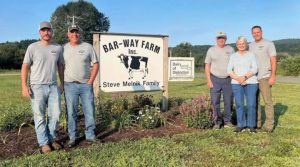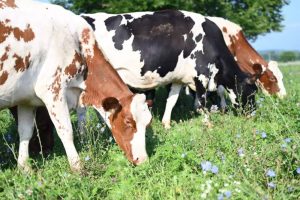
Dairy farmers have faced a crash in milk prices amid the coronavirus pandemic in the last month when restaurants, workplaces and schools shuttered across the country. Many dairy operations have even dumped their cows’ milk as the initial splash of at-home consumption has tapered off and the restaurant industry has nearly disappeared.
“You can’t shut down cows. You can’t turn them off like a faucet,” Zoey Nelson, 27, a sixth-generation dairy farmer in Waupaca, Wisconsin, told NBC News. “Just to see it literally going down the drain — it’s devastating.”
The Center for Dairy Excellence called the effect of the coronavirus on the industry “unprecedented in terms of its magnitude, its reach and its complications.” Grocery stores across the country have set purchase limits for certain products — including milk — in an effort to prevent panic shopping. This, combined with the decrease in food service demand where dairy products are usually consumed at restaurants or schools, has had a significant impact.
“We’re seeing a demand decrease of approximately 12 to 15 percent across the entire United States,” Jennifer Huson of the Dairy Farmers of America said on a dairy industry call this week, “and those demand changes are resulting in a lot of uncertainty.
Unlike many other agricultural commodities, milk is perishable and cannot be stored for a later date when the market demand and price rise.
Nelson, along with her sister Sydney Brooks and other family members, produce milk with an operation of 600 cows. They sell all of their milk to a Wisconsin-based cheese company and find themselves among those forced to pour out their milk.
“On your next grocery trip, please consider buying more cheese, butter, milk, yogurt, ice cream and cottage cheese to help support dairy farmers through Wisconsin and also the nation,” Brooks said.
Before the pandemic hit the United States, dairy farmers had already faced drops in prices by roughly 40 percent over the last six years, a dip that has come as a result of a glut of product in the American dairy market, the expansion of corporate farming and an increase in the consumer consumption of milk alternatives, such as soy, almond and oat milk.
“The fear of the unknown has crashed the price by almost one-third of where it was at [in the last month],” said Stephen Maddox, a Riverdale, California, dairyman who operates a farm with 3,000 cows. He also employs 65 workers and said that he would have to temporarily shut down operations if one of the workers contracted the virus.
“That’s a little distressful, to say the least,” he said. “The thing about the dairy industry or the vegetable industry is that you have a perishable commodity that you’ve got to harvest every day, and you got to do something with it.”
President Donald Trump, in a tweet Thursday, suggested that he told Secretary of Agriculture Sonny Perdue to “expedite help to our farmers, especially to the smaller farmers who are hurting right now.”
More than 3,000 dairy farms closed in 2019, according to the United States Department of Agriculture’s annual report.
“We fear that we will be losing more dairy farms without nearby assistance in the coming year,” said Dan Basse, the president of AgResource who also maintains an Ohio dairy farm. “They’re looking at substantial losses today which is why the dairy farmer — after years of struggles — is so upside down in terms of the balance sheet.”
Dairy farmers had hoped 2020 would be the continuation of slight gains seen last year after initial agreements were made to incrementally increase the nation’s access to sell into the Canadian dairy market as part of the United States-Mexico-Canada Agreement. Prices for American dairy slightly grew last year.
“Like every struggle that has come to the farm, I think dairy will make it through it, but this has tested our supply chain like nothing else,” said Mike North, president of Commodity Risk Management, a leading agricultural risk management group.
Pennsylvania Gov. Tom Wolf said Friday that concerns about farmers and their futures are discussed every day in his office; the state is home to nearly 6,000 dairy farms.
“You’re pointing at a real problem and that is in the short term while the readjustment is taking place,” he told reporters on a call. “The producers and the processors are used to one channel of demand and that channel has changed abruptly.”
In an effort to alleviate some of the uncertainty, Pennsylvania Secretary of Agriculture Russell Redding halted grocery stores’ ability to put a purchase limit on dairy products.

























